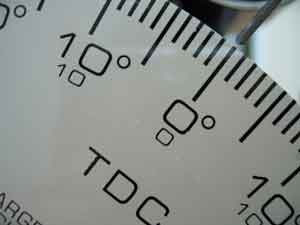 Entry-level racers and performance enthusiasts who are involved in drag, oval or street performance often have difficulty understanding spark advance.
Entry-level racers and performance enthusiasts who are involved in drag, oval or street performance often have difficulty understanding spark advance.
The cool thing about ignition timing is you can usually get a considerable performance increase for little or no money. But, some time and effort will be required.
Let’s start with a simple explanation of why we need spark advance and how much of it we want.
First – When you hook up the timing light to the #1 spark plug wire and it flashes a light beam onto the timing tab, it’s showing you when the spark occurs, NOT when the ignition occurs and the explosion that starts to push the piston down the cylinder.
We want this to happen just as the pistons reach the top of the compression stroke, but it takes time for the spark plug to ignite the fuel mixture. This “time” is measured in crankshaft degrees and is the difference between when the plug fires and the explosion occurs to push the piston down the cylinder – producing the power stroke.
Next – How much “time” or how many degrees of advance is correct. Well, that changes with each application but in most cases it will be as much spark advance as we can get as soon as we can get it without having detonation or “ping”.
Now that we know why we want spark advance and that we want all we can get without detonation – How do we get it?
If the engine is already in the car and running, we will have to hope the timing mark is correct. If you are building an engine or having one built at a shop, make sure the timing mark is correct; use a dial indicator on the #1 piston head to find “top dead center.” Also, if the damper is easy to get to, put a 38° mark on it to use as a reference on the stock timing tab. The formula we use is Dia.×3.1416÷360×38 (Diameter of the dampener/balancer × PI ÷ 360°×38°, or with numbers: 8×3.1416(25.1328)÷360(0.0698" per degree)×38°(2.6529" which you mark on your balancer away from your TDC mark), this distance will be 38° on whatever diameter damper you are using.
Now we know the timing tab is correct, and we have a 38° mark on the damper, we can now start to work on our timing “curve.”
Most racing and street performance ignitions do not have vacuum advance and the stock type distributors that are sent to a shop to be recurved should have the vacuum advance removed and locked out. For this reason we will deal only with mechanical advance. If you send your distributor to a shop to be recurved they can get you pretty close to the correct curve on a distributor machine. We usually install a 26° mechanical curve that starts about 100 rpm higher than the engines idle rpm and have all 26° in by 2,800 rpm, this is a good general purpose timing curve when used with 12° initial timing set at engine idle.
This, however, is not perfect or optimum for any one combination.
A street/strip car that runs on pump gas may “ping” with this much spark advance and will require less initial advance or heavier springs to slow down the “curve.” Where as a low compression, low stall speed converter car may respond better with more initial spark advance or lighter springs for a quicker “curve” – but watch it if you begin your mechanical advance curve at or below the idle rpm, the car will be a real pain in the ass to drive and tune.
For circle track applications, these motors almost always operate over the rpm where total advance is needed so the timing “curve” is not nearly as important as having the correct total spark advance. This is where the 38° mark is very handy to have. We have had much success with instant advance curves in these engines. This is where we start engines on about 10° of spark advance and the instant it fires, the timing goes to the total advance – as long as you use high enough octane fuel this gives a nice clean idle and very quick response.
As you can see, there’s a lot you can do with ignition timing, and every engine will require a specific curve and total spark advance, but if you take the time to sort out what’s best for your engine, you will gain performance without spending a lot of money, and isn’t that what we are all after.
Tech Tip courtesy of Jensen’s Engine Technologies.













